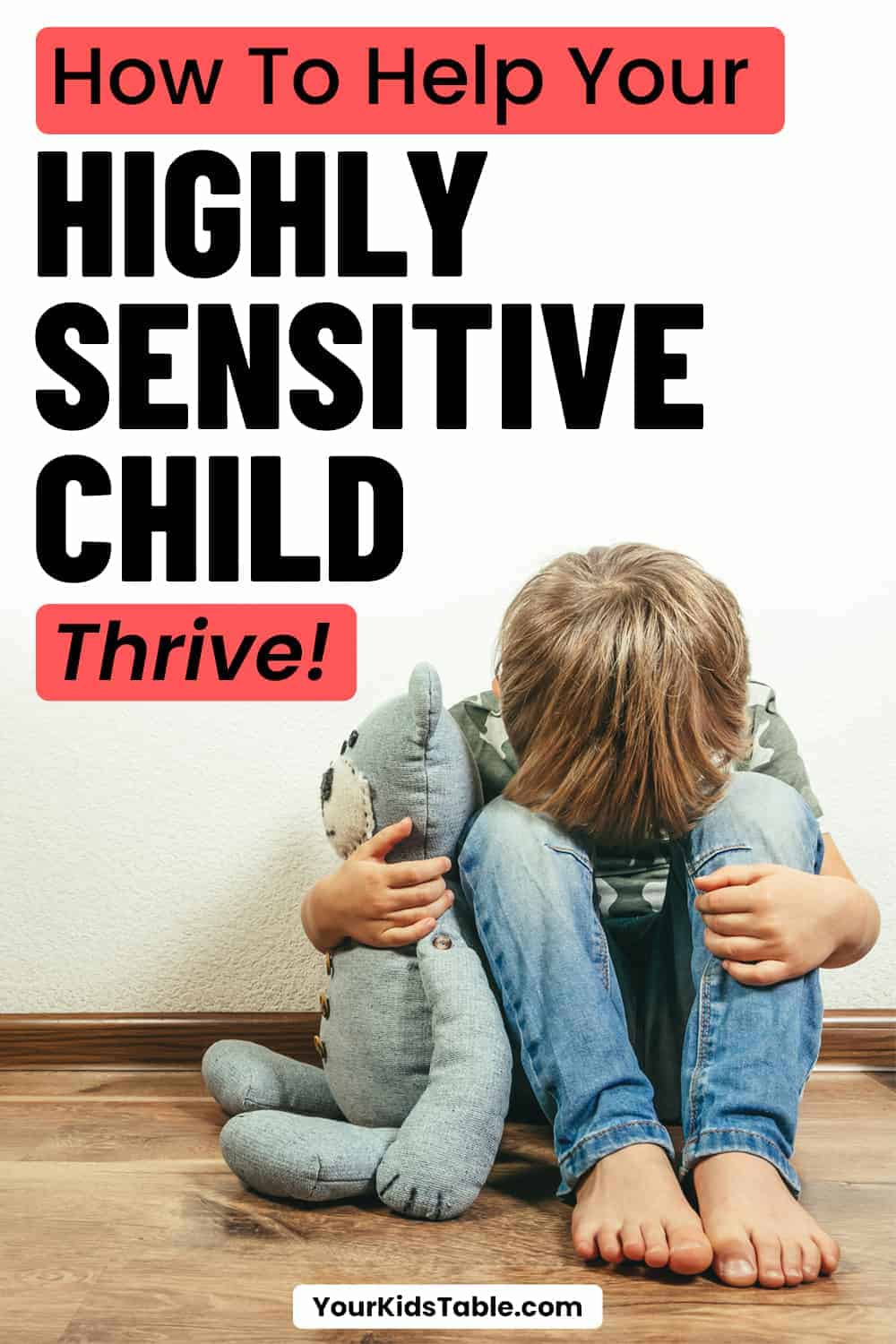20+ signs of a highly sensitive child that often feels and experiences the world deeply and with more sensitivity. Learn how sensory sensitivities also play a role and what you can do to help your child cope with these challenges.
Affiliate links used below. See our full disclosure.
I’ll never forget this vacation.
Our family had been planning to visit relatives in lake country Minnesota for months and it was finally here. It was the 4th of July, and we had been preparing for an evening of fireworks on my in-law’s pontoon.
We loaded everyone up and spent over an hour driving the boat through a maze of connecting lakes until we found the perfect spot, free floating under the stars, among hundreds of other boats. In this small town, this was the event of the year and everyone was excited.
The first fireworks went off, and I glanced over at my 3-year-old, eager to watch her experience it all with wonder. Kids love fireworks! I could hear children on other boats squealing in delight.
When our eyes met, all I could see was terror and fear. Within seconds, she was hysterically crying, shaking, and covering her ears. She was inconsolable, and despite all of our efforts to calm her, she continued to melt down as we scrambled to help.
You would think as an occupational therapist who specializes in pediatrics, I would have prepared for this. But I was completely stunned by my lack of ability to anticipate my daughter’s reaction.
I instantly thought back to comments people had made about her over the years:
“She seems like a highly sensitive child.”
What is a “Highly Sensitive Child”?
Maybe you’ve heard the phrase “highly sensitive child” going around.
It has gained popularity through social media from a psychology or emotional standpoint in recent years, first for adults as a Highly Sensitive Person, and then for kids. It’s typically used to describe a kid who is especially “difficult,” “volatile,” or “over-the-top.”
Those labels often leave parents (and the child) feeling hurt, judged, and frustrated!
Highly sensitive child wasn’t a term until recently, and as a parent, I too found the labels being thrown on my child to be hurtful and not even accurate.
There had to be more to her temperament than just “difficult” and “sensitive.”
With advancements in understanding the sensory system better, (check out our article on all things sensory processing here) we are finding that kids who seem to be “highly sensitive” are actually reacting to their own sensory needs and challenges.
Their reactions can sometimes appear extreme or inappropriate to those who don’t know what’s going on.
These highly sensitive kids can become easily overwhelmed by their environments, seem over-reactive to change or surprises, and are generally more inflexible than their less sensitive peers.
There is a huge range of signs that your child might be considered “highly sensitive” and they can be as varied and unique as each individual person.
And while we all show areas of sensitivity, especially when hungry, tired, or under stress, a highly sensitive child will exhibit numerous signs and at a more frequent rate.

Signs of a Highly Sensitive Child
As I mentioned in my own experience, it can be easy to mistake the signs of a highly sensitive child for other characteristics such as stubborn, emotionally reactive, and anxious.
Because this difference can be difficult to pinpoint, a highly sensitive child checklist can help you determine if your kid might fall under the highly sensitive category.
While there is no “highly sensitive child test”, children in this category may demonstrate the following red flags:
- Wearing clothing is an ordeal: Tags, socks, certain fabrics, and fit of clothes are bothersome.
- Daily hygiene tasks are a battle: Toothbrushing, hair washing (and bathing in general), nail trimming, and keeping the body clean are all difficult and can cause a meltdown.
- Physical touch is met with avoidance: Needing increased personal space, hating to be hugged or held, even in infancy.
- Loud or unexpected noises are a no-go. Fire drills, blenders, vacuum cleaners, and automatic toilets are all scary and avoided.
- Picky eating: avoidance of new textures and flavors, short order cooking requests, and minimal diversity in tolerated foods.
- Poor attention or hyperactivity: Constant squirming and wiggling. Slowing down to focus is a difficult feat, and school has commented on decreased listening skills when compared to peers.
- A constant state of “overstimulation.” Crowded places like stores or fairs, large groups of people cause a meltdown.
- Noticing slight changes in their environment, such as odors or objects that are moved.
- A rigid routine is needed, and child feels overwhelmed by surprises.
- Responding better to gentle rather than critical feedback. Even gentle redirection is met with tears.
- Having a hard time falling asleep after a lot of stimulation.
- Picking up on others’ emotions easily.
- Sensitivity to pain or discomfort and might even say things like water in the shower, or clothing “hurts.”
- Frustrated outbursts occur if an activity cannot be completed perfectly.
*Get on the waitlist for our once a year 7 Day Thriving with Sensory Challenge to help your child with all these signs!*
Highly Sensitive at Different Ages
You may wonder if being highly sensitive is something that your child was born with, or if it somehow came out through their environment or life experience.
It’s the classic nature vs. nurture argument that has been discussed by child development professionals for ages.
What we know now, is that while there is a biological and experiential component to almost everything, temperament is fairly hard wired.
What this means is that your highly sensitive child was likely a highly sensitive infant and toddler, and will likely become a highly sensitive adult.
However, our coping skills and sensory sensitivities do change over time, and it is possible to have the severity of sensitivity decrease over time as well.
Have you ever heard of the colicky baby that needs to be aggressively bounced on a yoga ball to fall asleep?
Through the lens of “highly sensitive” rather than “difficult,” we can understand that this baby is responding to vestibular input through bouncing on a ball, and has a higher need for it than a baby described as “easy.”
It’s this same perspective shift that has normalized many common things like weighted blankets, noise canceling headphones, and chewing gum.
These are all areas of sensory regulation that have become widely accepted, but point directly at an underlying sensory need that many people have.
The truth is, we all have sensory needs and sensitivities. Your highly sensitive child may just have more.
In many ways, being highly sensitive and having sensory difficulties are one in the same.
Head to 10 Sensory Red Flags for more signs of sensory challenges.
Highly Sensitive Child in the Classroom
We’ve discussed what highly sensitive children may have looked like in infancy, but what does this mean for these children through the school-aged years?
From the highly sensitive child checklist above, you can see that some of the areas relate directly to the classroom.
Things like attention difficulties, problems sitting still, and overreactions to direction and discipline can make learning more challenging to the highly sensitive child.
These children may benefit from regular sensory input, gentle instruction, and supports like visual schedules and fidgets.
We will discuss other ways to help your highly sensitive child in the classroom, but a great way to start is by using a sensory corner and morning sensory routine.
The Connection Between Sensory Processing and Emotional Regulation
Now that you know the link between highly sensitive kids and sensory sensitivities, there’s another connection to be made.
And it might be why highly sensitive children are so often labeled as emotional and even dramatic.
Our ability to tolerate the world around us, our sensory processing, is directly related to our ability to emotionally regulate ourselves.
Think about it this way:
During our 4th of July fireworks disaster, my daughter was unable to tolerate the loud noises, the rocking of the boat, the giant crowds of people… it was all TOO MUCH.
At 3-years-old, she didn’t have language skills to tell me how she was feeling, and she certainly didn’t have the emotional regulation to tell me, “Mom, I hate this!”
Instead, she skipped over the coping skills (that she didn’t have) and went straight to overstimulation. It all came out as a giant meltdown.
Fortunately, as an OT, I am familiar with ways to decrease the sensory overload for next time, and hopefully build coping skills for the future.
The whole experience showed me that we had some work to do for building self regulation skills.

How to Help Your Highly Sensitive Child
As you probably know by now, if you have a highly sensitive child, generic parenting advice and help may not apply to your child.
Getting help with your highly sensitive child requires a little different approach.
The following 6 tips can help you connect with your child’s specific sensitivities, and help them better cope with the world around them.
1. Acknowledge your child’s emotions, AND help them learn to name them
You can start in early infancy and practice throughout your child’s development. When they cry, say “you seem sad.” Look at emotional depictions in books or videos and help your child label what they see.
Try to not correct your child’s emotional behavior, but rather, objectively label how they’re feeling and allow them to feel it.
2. Build a toolkit of strategies and coping skills for each emotion
Once your child understands they feel overwhelmed, give them something to do.
For example: “When I feel overwhelmed, I can: jump on the trampoline, read a book, listen to music, or take a walk.” These options will depend on your child’s age and specific needs, and may change over time..
3. Prepare your child ahead of time and plan for issues that may arise
I completely blew this with the fireworks scenario.
You know your child and their challenges. Pack calming items ahead of time and go over strategies for difficulties that may arise. Can you find a quiet corner to take a break? Bring a special snack? What about noise canceling headphones?
I’m preaching to my past self on that last one.
If your child is old enough, preparing them for what is to come and asking what they need to feel calm is a great way to teach self regulation.
4. Build in time to unwind after especially stressful situations
Allowing extra time as much as possible for transitions, getting home from school, and bedtime routine can make a big difference.
Much like using a morning routine to help your child focus all day at school, this after school routine can decrease the potential for the evening meltdown once they get home.
5. Avoid harsh reactions and discipline
In the therapy world, we call modeling our calm reactions to our children “co-regulation.”
It is a powerful technique for sharing your regulated state with your child, especially during a meltdown. Highly sensitive children can easily perceive your emotions, so remaining neutral and calm will help keep their behavior from escalating.
6. Make a sensory routine
This last strategy is a way to encourage appropriate sensory processing and self regulation as part of day-to-day life so that your child learns coping strategies over time that actually decrease their sensitivities.
You can start with these 4 Sensory Routines that help calm and regulate your child.
Adding regular sensory input into your child’s day can help address challenges before they happen because they are more calm and receptive to respond appropriately to stressors instead of becoming overwhelmed.
It is my hope that these tips help you see your child’s sensitivities as something you can work through together, teaching them to advocate for themselves along the way.
Get More Help for your Highly Sensitive Child
Grab my 21 Sensory Red Flags You Might Be Missing Printable. Whether sensory is new to you or not, it’s an important checklist to have.
**Click here to grab your free printable!**
Laura Mau is a licensed occupational therapist and member of the Your Kid’s Table team. She has over 8 years of clinical experience in helping families navigate complex feeding and eating, sensory processing, and reaching developmental milestones with their children. She currently practices in Colorado and has 2 young kids of her own.
Alisha Grogan is a licensed occupational therapist and founder of Your Kid’s Table. She has over 18 years experience with expertise in sensory processing and feeding development in babies, toddlers, and children. Alisha also has 3 boys of her own at home. Learn more about her here.
